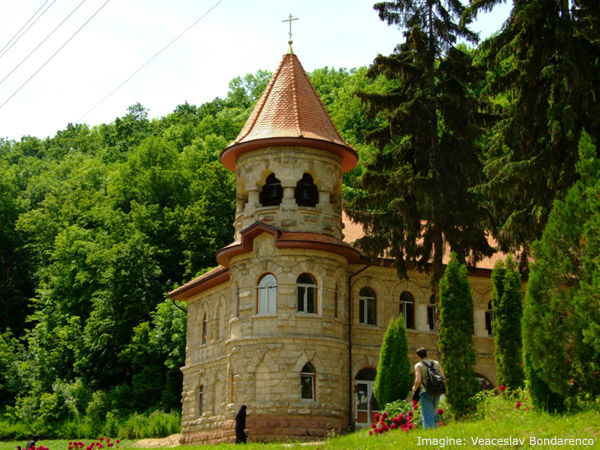Rudi Monastery also known as Rughi Monastery is located on the bunch of the Nistru River, at the distance of 15 km from Otaci town. It is a friary.
 In 1777, with the blessing of bishop Inochentie from Husi (1752 – 17820) a Moldovan style stone church in the name of the Holy Trinity was funded. It was built on the estate of brothers Andronachi and Teodor Rudea with the financial support of the noble man Donciu from Mavilau (Podolia).
In 1777, with the blessing of bishop Inochentie from Husi (1752 – 17820) a Moldovan style stone church in the name of the Holy Trinity was funded. It was built on the estate of brothers Andronachi and Teodor Rudea with the financial support of the noble man Donciu from Mavilau (Podolia).
“On June 1, 1777 on behalf of the Holy Trinity and St Nicholas, this temple was founded at the times of the blessed noble man Grigore Alexandru Ghica Voda with the blessing of sacred Inokentie – the bishop of Husi, and with the efforts of noble man Simion Donciu. It was built on the territory of Andronachi Rudea (Teodor Rudea brother) estate” – these data were confirmed in a superscription written in Slavonic language, which was cherished up till now. In accordance with another superscription, the monastery was founded on behalf of the Holy Trinity, at times of the noble man Grigore Alexandru Ghica, with the blessing of bishop Inochentie.
In the Holy Trinity church of Rudi monastery archive , dating from 1835, the following information can be found: “ We do not possess any personal land, our monks’ cells are built from 19 billows, we are not carried by anybody and do not receive help from anywhere”. Buying out the Rudi family estate, proprietary Mihai Bogus ruined the monastery. In 1845 his daughter Anastasia died tragically, only a year after her death, Bogus second daughter died as well. This was a kind of punishment for Bogus and at the age of 62 he passed away. Bogus family was buried on the monastic complex territory which was forsaken by nuns in 1846. There would be seen a stone with the inscription “Mihai Bogus, died in 1856”. Near his grave, the graves of his daughters would be seen too. On the left wall of the hermitage, another inscription would be seen: “Here were buried monastery founders Teodor and Andronachi Rudi”.
 In 1846, local authorities took the decision to close Rudi Monastery church; it was taken under the guidance of Rudi village parish. Mihai Rosea – a near relation to Bogus became the monastery proprietary, he transformed the holy place into an inhabitancy for servants. The monastic complex was abandoned and partially demolished.
In 1846, local authorities took the decision to close Rudi Monastery church; it was taken under the guidance of Rudi village parish. Mihai Rosea – a near relation to Bogus became the monastery proprietary, he transformed the holy place into an inhabitancy for servants. The monastic complex was abandoned and partially demolished.
On October 24, 1921 with the support of Archbishop Visarion Puiu, Rudi Monastery was reopened. Its restoration was approved by local authorities.
During the World War II the monastery was under the guidance of hegumen Ioachim Barbus. At that time 30 monks inhabited the monastic territory.
In 1948 Archbishop Benedict of Chisinau city was ordered and imposed to close Rudi Monastery. According to local witnesses, the monastery estate was confiscated, its monks taking refuge in other monasteries.
The monastic complex was transformed into an orphanage, and later, it became a hospital for children. The Holy Trinity church became a deposit. In 1990 the hospital was evacuated.
 In 1992, Rudi Monastery was re-settled by three monks: monk Malchisedec and two monks from Romania. In 1993, renovation works began at the monastery. A year later, the Holy Trinity restoration also commenced.
In 1992, Rudi Monastery was re-settled by three monks: monk Malchisedec and two monks from Romania. In 1993, renovation works began at the monastery. A year later, the Holy Trinity restoration also commenced.
In the “Manastirea Rudi” report published in “Historical monuments commission” book in 1928, engineer – architect Nicolae Tiganco stated the following: “Rudi Monastery is settled on a becomingly place. Its architecture comprises a well defined Moldovan style dating from XVI century. The church takes medium shaping of 17,70 m x 12,30 m . The height of the church is 9 m, its dome, including the cross is 20 m high. The walls are approximately 1 m thick. The church contains a pronave and nave. The dome is built up according to the traditionally Moldovan architecture and namely – tier upon tier semicircular arcs. Icons of saints are painted on the the three apsides of the church.
In 1921, Rudi monastery church was included into the list of historical monuments well-formed according to the old Moldovan style.

Translated from Romanian by Felicia Lupasco, Moldova.ORG




